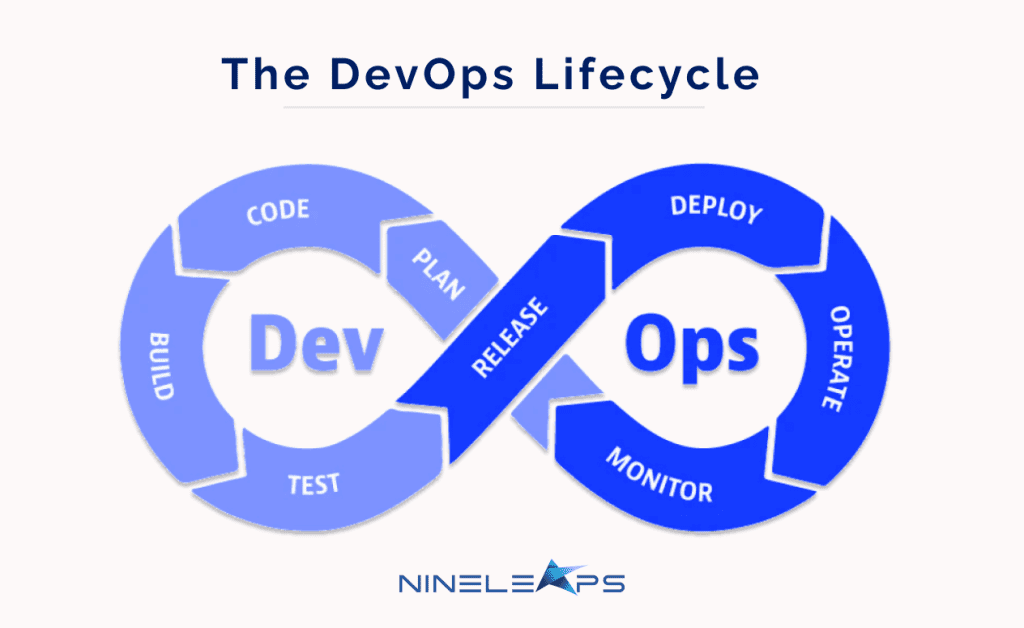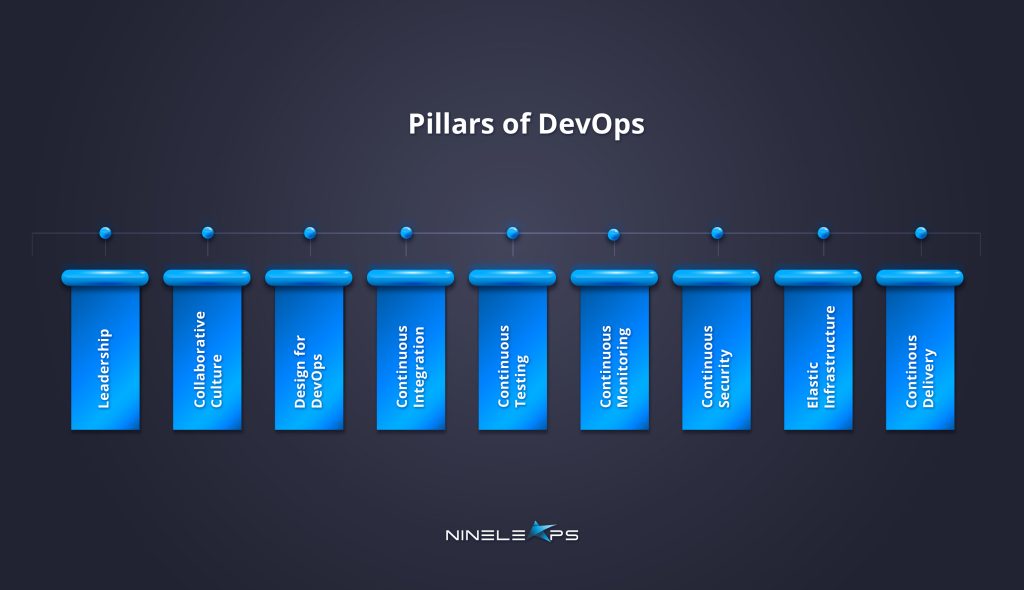Understanding DevOps and its implications can help organizations streamline their product engineering goals and unlock paramount value. DevOps, short for Development and Operations, represents a fundamental shift in the way software development and IT operations collaborate.
DevOps is not merely a set of tools or practices; it’s a cultural and philosophical approach to software delivery that emphasizes collaboration, automation, and continuous improvement. At its core, DevOps aims to break down silos between development and operations teams, fostering a culture of shared responsibility and ownership throughout the software lifecycle.
Implementing DevOps methodologies yields numerous benefits, including accelerated delivery cycles, higher-quality software releases, improved deployment frequency, and enhanced overall efficiency. By automating manual processes, reducing deployment failures, and fostering a culture of innovation, organizations can achieve faster time-to-market and greater customer satisfaction.
The DevOps lifecycle encompasses a series of interconnected stages, each crucial for ensuring the seamless delivery and operation of software products. From initial planning and development to continuous monitoring and feedback, this iterative approach enables teams to iterate rapidly, respond to change efficiently, and deliver value to end-users consistently.
The nine pillars of DevOps provide a comprehensive framework for organizations to enhance their software development and delivery processes. Here’s a brief overview of each pillar:
Leadership: Leadership plays a crucial role in driving DevOps adoption and performance. By gaining insight into leadership practices, organizations can better understand how leadership influences DevOps initiatives and foster a culture of innovation, collaboration, and continuous improvement.
Culture: Cultivating a culture of collaboration and communication is essential for successful DevOps implementation. Identifying opportunities to improve cross-functional collaboration and communication helps break down silos between teams, foster trust, and promote shared ownership of DevOps practices.
Design for DevOps: Analyzing application development practices enables organizations to identify improvements that streamline the development process and align with DevOps principles. By integrating DevOps practices into the design and development phases, teams can accelerate delivery and improve overall performance.
Continuous Integration: Continuous Integration (CI) involves automating the process of integrating code changes into a shared repository. Analyzing branching and integration workflows helps identify bottlenecks and improvements for optimizing build and packaging processes, leading to faster and more reliable software releases.
Continuous Testing: Continuous Testing is crucial for ensuring the quality and reliability of software releases. Analyzing end-to-end testing workflows and tools helps identify opportunities to accelerate testing, improve test coverage, and enhance the overall quality of tests, ultimately reducing time-to-market.
Elastic Infrastructure: Scalable and efficient infrastructure is essential for supporting DevOps workloads. Analyzing systems and services for orchestrating and hosting applications provides insights to improve performance and resource utilization, enabling organizations to scale infrastructure on demand and meet changing demands effectively.
Continuous Monitoring: Continuous monitoring provides visibility into the performance, availability, and health of applications and infrastructure. Analyzing monitoring workflows and tools helps improve visibility for both business and technical stakeholders, enabling proactive detection and resolution of issues to ensure optimal performance and reliability.
Continuous Security: Integrating security practices into the continuous delivery pipeline is critical for maintaining the integrity and security of software releases. Analyzing security practices and tools helps identify opportunities to embed security into every stage of the DevOps lifecycle, ensuring that security is a fundamental aspect of DevOps initiatives.
Continuous Delivery/Deployment: Continuous Delivery/Deployment (CI/CD) practices enable organizations to deliver software changes quickly, safely, and efficiently. Analyzing delivery and deployment practices helps identify improvements for safer, faster, and more efficient releases, ultimately enhancing the agility and competitiveness of the organization.
Key Components of DevOps
Continuous Integration (CI): Automating Code Integration and Testing
Continuous Integration involves automatically integrating code changes into a shared repository and running automated tests to detect and address issues early in the development cycle. By enabling developers to merge code frequently and identify defects promptly, CI promotes collaboration and ensures the stability of the codebase.
Continuous Delivery (CD): Ensuring Rapid and Reliable Software Releases
Continuous Delivery extends the principles of CI by automating the deployment process and enabling teams to release software reliably at any time. With CD, organizations can streamline the release pipeline, minimize manual intervention, and deliver new features and updates to users swiftly and safely.
Infrastructure as Code (IaC): Managing Infrastructure Through Code
Infrastructure as Code revolutionizes the management of IT infrastructure by treating infrastructure configurations as version-controlled code. By defining infrastructure requirements in code, teams can provision, configure, and manage resources more efficiently, leading to greater consistency, scalability, and reproducibility.
Microservices Architecture: Breaking Down Applications into Smaller, Independently Deployable Services
Microservices architecture decomposes monolithic applications into smaller, loosely coupled services that can be developed, deployed, and scaled independently. By promoting modularity, resilience, and autonomy, microservices enable teams to iterate quickly, adapt to changing requirements, and deliver software more effectively.
Containerization with Docker: Streamlining Application Deployment and Scalability
Docker containerization provides a lightweight and portable solution for packaging, distributing, and running applications in isolated environments. By encapsulating dependencies and configurations within containers, Docker simplifies deployment, accelerates time-to-market, and enhances resource utilization across different computing environments.
Orchestration with Kubernetes: Managing Containerized Applications at Scale
Kubernetes, an open-source container orchestration platform, automates the deployment, scaling, and management of containerized applications. By providing powerful scheduling, networking, and monitoring capabilities, Kubernetes empowers organizations to deploy and operate containerized workloads efficiently, at any scale.
Implementing DevOps in Your Organization
Assessing Current Processes and Identifying Areas for Improvement
Before embarking on a DevOps journey, it’s essential to assess existing processes, workflows, and cultural norms within your organization. By conducting a thorough evaluation, you can identify bottlenecks, inefficiencies, and areas ripe for improvement, laying the groundwork for successful DevOps adoption.
Building a DevOps Culture: Collaboration, Communication, and Accountability
DevOps is not just about tools and technologies; it’s about fostering a culture of collaboration, communication, and accountability across teams and departments. By promoting transparency, trust, and shared goals, organizations can break down silos, bridge the gap between development and operations, and drive innovation at every level.
Tools and Technologies for DevOps Implementation
A wide array of tools and technologies are available to support DevOps practices and workflows, from version control systems and automated testing frameworks to deployment pipelines and monitoring solutions. Selecting the right tools that align with your organization’s needs and objectives is crucial for achieving success in your DevOps journey.
Creating a DevOps Roadmap and Setting Realistic Goals
Developing a clear roadmap and establishing measurable goals are essential steps in implementing DevOps effectively. Define key milestones, timelines, and success criteria, and involve stakeholders from across the organization in the planning process. By setting realistic expectations and tracking progress regularly, you can ensure steady progress toward your DevOps objectives.
Challenges and Solutions in DevOps Adoption
Overcoming Resistance to Change Within the Organization
Resistance to change is a common obstacle in DevOps adoption, as it requires teams to embrace new processes, tools, and mindsets. To overcome resistance, organizations must invest in change management initiatives, provide adequate training and support, and demonstrate the tangible benefits of DevOps practices through pilot projects and success stories.
Addressing Security Concerns in a DevOps Environment
Security is a top concern in DevOps, as the rapid pace of development and deployment can introduce vulnerabilities and risks. To address security concerns, organizations should implement robust security controls, conduct regular security assessments and audits, and integrate security practices throughout the software development lifecycle.
Managing Cultural and Organizational Silos
Cultural and organizational silos can impede collaboration and communication across teams, hindering the adoption of DevOps principles. To break down silos, foster a culture of transparency, inclusivity, and shared responsibility. Encourage cross-functional collaboration, promote knowledge sharing, and celebrate achievements that demonstrate the value of working together towards common goals.
Dealing With Legacy Systems and Technical Debt
Legacy systems and technical debt pose significant challenges for organizations transitioning to DevOps. To address these challenges, prioritize refactoring legacy code, automating manual processes, and gradually modernizing infrastructure and applications. By investing in technical debt reduction efforts and adopting a pragmatic approach to legacy system migration, organizations can mitigate risks and pave the way for successful DevOps implementation.
Best Practices for Successful DevOps Implementation
Automating Repetitive Tasks to Increase Efficiency
Automation lies at the heart of DevOps, enabling teams to streamline repetitive tasks, reduce manual errors, and accelerate time-to-market. By automating processes such as code deployment, testing, and infrastructure provisioning, organizations can achieve greater efficiency, consistency, and reliability in their software delivery pipelines.
Emphasizing Continuous Feedback and Improvement
Continuous feedback is essential for driving continuous improvement in DevOps practices. Encourage open communication channels between development, operations, and other stakeholders to solicit feedback, identify areas for improvement, and iterate on processes iteratively. By embracing a culture of experimentation, learning, and adaptation, organizations can foster innovation and stay ahead of evolving market demands.
Monitoring and Analyzing Performance Metrics for Optimization
Effective monitoring and performance analysis are critical for identifying bottlenecks, detecting anomalies, and optimizing system performance in a DevOps environment. Implement comprehensive monitoring solutions that track key metrics such as application performance, infrastructure utilization, and user experience. By leveraging real-time insights and analytics, teams can proactively identify issues, optimize resource allocation, and ensure the reliability and scalability of their software systems.
Encouraging Cross-Functional Collaboration and Knowledge Sharing
DevOps thrives on collaboration and knowledge sharing across diverse teams and disciplines. Foster a culture of cross-functional collaboration by organizing regular meetings, workshops, and knowledge-sharing sessions where team members can exchange ideas, insights, and best practices. By breaking down silos and fostering a sense of collective ownership, organizations can harness the full potential of their teams and drive innovation at every level.
Tools and Technologies
As you embark on your DevOps journey, it’s essential to have the right tools and resources at your disposal. Here’s a curated list of essential tools for DevOps implementation:
Jenkins: An open-source automation server for continuous integration and continuous delivery.
GitLab: A web-based DevOps lifecycle tool that provides version control, CI/CD, and collaboration features.
Ansible: A simple, powerful automation platform for orchestrating application deployment, configuration management, and infrastructure provisioning.
Docker: A platform for building, shipping, and running containerized applications.
Kubernetes: An open-source container orchestration platform for automating deployment, scaling, and management of containerized workloads.
Mastering DevOps is essential for streamlining your software development process, accelerating time-to-market, and delivering value to your customers faster. By embracing DevOps principles, leveraging key components, and adopting best practices, organizations can overcome challenges, drive innovation, and achieve success in today’s dynamic digital landscape.
Start your DevOps journey today and unlock the full potential of your software development capabilities. Write to us.





